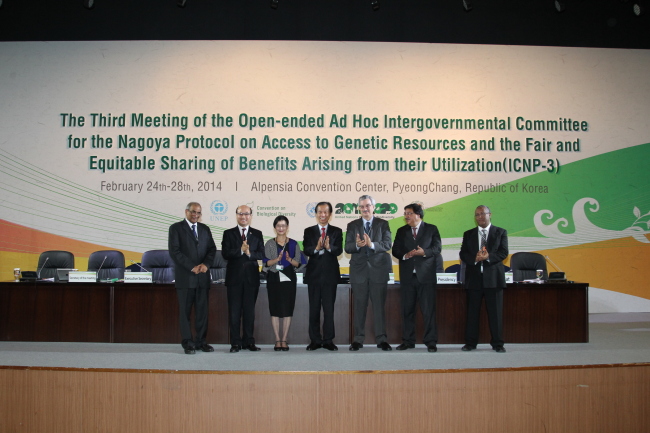About 20,000 participants are expected to gather at the 12th meeting of the Convention on Biological Diversity, slated for Sept. 29-Oct. 17 in an eco-friendly district in South Korea, the local unit of the organizing committee said Monday.
Pyeongchang, Gangwon Province is the host of the biennial gathering, which is to be convened under the theme of “Biodiversity for Sustainable Development.”
The Korean secretariat predicts that the number of participants will surpass that of previous conventions: around 16,000 in Hyderabad, India, in 2012 and 13,000 in Nagoya, Japan, in 2010.
The projected 20,000 participants are likely to come from 194 parties including international organizations, businesses and NGOs.
The Convention on Biological Diversity was signed by more than 150 nations at the Rio “Earth Summit” in 1992 to propel sustainable development.
“CBD recognized that biodiversity encompasses more than plants, animals, microorganisms and their ecosystems,” said Kim Sang-hoon, director general of the Korean Secretariat of the U.N. Biodiversity Conference 2014.
The global community has shared the view that biodiversity is essential for human life, food safety, medicine, the atmosphere, water quality, places of living and a sound environment for living.
 |
Gangwon Province Gov. Choi Moon-soon (center) poses during the meeting of the Open-ended Ad Hoc Intergovernmental Committee for the Nagoya Protocol on access to genetic resources in Pyeongchang, Gangwon Province, in February. The forum was held ahead of the 12th meeting of the Convention on Biological Diversity. (Korean Secretariat of the U.N. Biodiversity Conference 2014) |
“The 12th meeting is scheduled to undertake a mid-term review of the implementation of the Strategic Plan for Biodiversity 2011-2020,” Kim said. “Further, it will develop a road map (dubbed the Pyeongchang Road Map) for the enhanced implementation of the Strategic Plan.”
The Pyeongchang Road Map will include enhanced mechanisms for technical and scientific cooperation, capacity-building, financial resources, and the integration of biodiversity into development plans and other national processes.
To facilitate the implementation of the road map through strengthened technical and scientific cooperation, South Korea plans to propose a BioBridge Initiative, effectively linking technological and scientific capacities as well as financial resources in advanced countries to the need for science and technology in developing countries.
In the midst of growing attention to the loss of biodiversity, leaders of the international community met at the United Nations Conference on Environment and Development in Rio de Janeiro in 1992. There they adopted the Convention on Biological Diversity.
The CBD was inspired by the world community’s growing commitment to sustainable development. It represents a dramatic step forward in the conservation of biological diversity, the sustainable use of its components, and the fair and equitable sharing of benefits arising from the use of genetic resources.
As of August 2014, 194 governments including the European Union have become parties to the Convention since it entered into force on Dec. 29, 1993.
Together with the United Nations Framework Convention on Climate Change adopted at the UNCED and the United Nations Convention to Combat Desertification adopted in Paris, France, in 1994, the Convention on Biological Diversity is one of three major international environmental conventions.
The Secretariat (or the de facto headquarters) of the Convention on Biological Diversity is located in downtown Montreal, Canada.
Meanwhile, South Korea has asked North Korea to join the upcoming conference in Pyeongchang. The invitation letter, which was signed by Environment Minister Yoon Seong-kyu, was sent to his Northern counterpart earlier this month.
By Kim Yon-se (
kys@heraldcorp.com)






![[Weekender] Korea's traditional sauce culture gains global recognition](http://res.heraldm.com/phpwas/restmb_idxmake.php?idx=644&simg=/content/image/2024/11/21/20241121050153_0.jpg)

